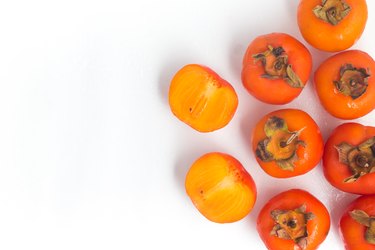
Dried persimmon is a tasty treat for fans of the spicy fruit. The drying process produces a dense, chewy date-like honeyed flavor with overtones of cinnamon and gingerbread. While the dried fruits can be used in a variety of persimmon recipes, you can enjoy them as a snack any time. The original drying process was developed in Asia and brought to the United States by Japanese immigrants. Persimmon trees are native to Asia (Diospyros kaki) and North America (Diospyros virginiana).
Traditional Japanese Dried Persimmon
Video of the Day
The hoshigaki drying method of preserving persimmons uses hachiya or other astringent persimmon types. The persimmons are picked in the fall, after the fruit has turned orange but is still hard and at a tongue-shriveling level of astringency. Leave the stems at 1 to 1/2 inches long.
Video of the Day
Dip the fruit in a solution of 1/8-cup bleach and 5 gallons of water. Rub the fruit with a terrycloth towel, rinse thoroughly and buff dry. Remove the top 1/2 inch of each piece of fruit and its green cap without disturbing the stem. Peel the fruit. Tie a 10- to 12-inch length of kitchen twine to each stem and suspend the fruit from a drying rack or ladder in the garage, carport or covered patio.
Do not allow the fruits to touch each other; they need air to circulate between them to dry properly and prevent mold. Use a fan to increase air circulation.
After the persimmons develop a leathery outer layer, in one to two weeks, begin massaging the fruits every four or five days at first; then, as they continue to dry, daily. The regular massaging breaks up the outer leathery layer and makes the inner pulp evenly textured. The fruit will develop a white coating in four to six weeks.
Once the fruits develop the sugary white coating, remove them from the racks and cut off the stems and base of the calyx. Place the dried fruits on baking sheets in a sunny window and allow them to dry for another week. Cover at night with a clean towel.
Dehydrate the Persimmons
The best way to dehydrate persimmons is in a dehydrator. You can dry both the astringent and non-astringent varieties; the drying process brings out the sugars in the fruit.
Wash the persimmons and remove the stems and green caps. Peel and slice the fruit crosswise into 1/4-inch slices. On the dehydrator trays, arrange the slices so they are not touching. Set the temperature at 100 degrees Fahrenheit, or according to the dehydrator manual. Dry for 24 hours, turning occasionally, until the centers of the fruit are leathery but still flexible and the edges nearly, but not quite, crispy.
Oven-Dried Persimmons
For faster results, dry persimmons in the oven. Heat the oven to its lowest temperature, approximately 150 to 250 degrees Fahrenheit. Slice fuyu persimmons, which are a non-astringent variety, crosswise into 1/4-inch-thick slices. Cover cooling racks with cheesecloth and place them on baking sheets. Arrange the sliced persimmons on the racks and place them in the oven.
Bake the persimmon slices up to 8 hours at 150 degrees, or 1 1/2 to 2 hours at 250 degrees, until the center of the fruits are dry and leathery and the outer edges curl. When cooking at 150 degrees for longer periods, turn the persimmons occasionally. If the oven is too hot, turn it off and let it cool for 1 hour, then turn it back on and continue baking the persimmon slices.
Storing Dried Persimmons
Allow dehydrated and oven-dried persimmons to cool before storing the fruits. Store sliced, dried persimmons in airtight containers in the refrigerator for up to three months, or freeze them for up to a year.
Wrap hoshigaki in plastic wrap; then store them in plastic bags at room temperature, refrigerate or freeze. When you're ready to enjoy the fruit, bring it to room temperature and slice crosswise. The hoshigaki will have a soft and chewy interior and a leathery exterior.